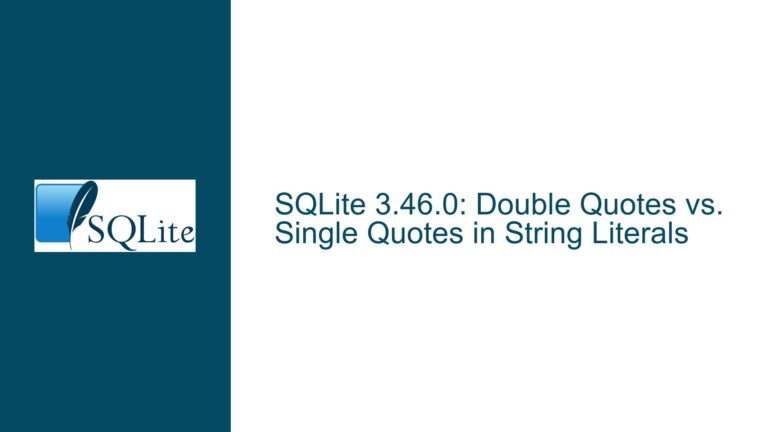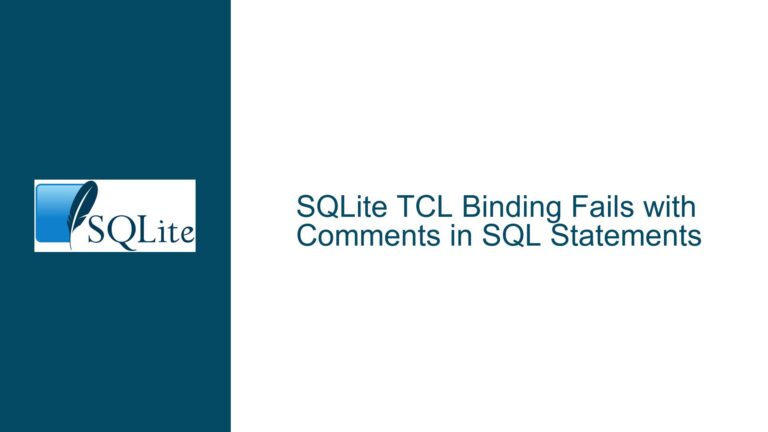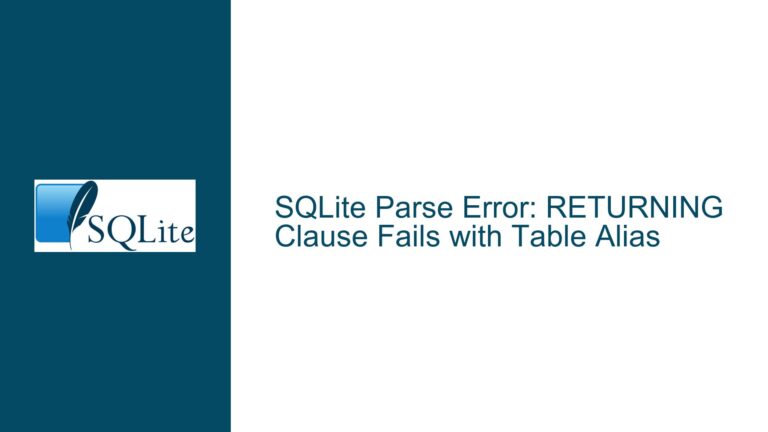and Fixing SQLite Not Equal Operator Behavior with NULL Values
SQLite Not Equal Operator Returning Unexpected Results
When working with SQLite, a common issue that developers encounter is the unexpected behavior of the not equal operator (!= or <>) when dealing with NULL values. Specifically, queries that use the not equal operator may return fewer rows than expected, or even no rows at all, when NULL values are present in the column being compared. This behavior can be particularly confusing for developers who are accustomed to other SQL databases where NULL handling might differ.
For example, consider a table testTable with the following structure and data:
CREATE TABLE "testTable" (
"recordId" INTEGER NOT NULL,
"testColumn" VARCHAR(36),
PRIMARY KEY("recordId")
);
The table contains the following records:
| recordId | testColumn |
|---|---|
| 1 | testValue |
| 2 | NULL |
| 3 | testValue |
| 4 | NULL |
| 5 | testValue |
| 6 | NULL |
When executing a query to find all records where testColumn is not equal to 'testValue', the result is unexpectedly empty:
SELECT recordId FROM "testTable" WHERE ("testColumn" != "testValue") ORDER BY recordId ASC;
Result: 0 rows returned
However, when the equal operator is used, the query returns the expected results:
SELECT recordId FROM "testTable" WHERE ("testColumn" == "testValue") ORDER BY recordId ASC;
Result: recordId 1, 3, 5
This discrepancy arises due to how SQLite handles NULL values in comparison operations. Understanding this behavior is crucial for writing correct and efficient SQL queries in SQLite.
Misuse of Quotes and NULL Comparison Semantics
The core issue lies in the semantics of NULL comparisons in SQLite. In SQL, NULL represents an unknown or missing value, and any comparison involving NULL yields NULL, which is considered neither TRUE nor FALSE. This behavior is consistent across most SQL databases, but it can lead to confusion when developers expect NULL values to be treated as distinct from other values.
In the example query, the not equal operator (!=) is used to compare testColumn with 'testValue'. However, when testColumn is NULL, the comparison NULL != 'testValue' evaluates to NULL, which is not TRUE. As a result, rows with NULL values in testColumn are excluded from the result set, leading to the unexpected empty result.
Additionally, the misuse of double quotes in the query can exacerbate the issue. In SQLite, double quotes are used to enclose identifiers (e.g., table names, column names) that contain special characters or whitespace. Single quotes, on the other hand, are used for string literals. While SQLite is lenient in some contexts and may accept double quotes around string literals, this practice can lead to subtle bugs and should be avoided.
For example, the following query uses double quotes around the string literal 'testValue', which is incorrect:
SELECT recordId FROM "testTable" WHERE ("testColumn" != "testValue") ORDER BY recordId ASC;
The correct query should use single quotes for the string literal:
SELECT recordId FROM "testTable" WHERE ("testColumn" != 'testValue') ORDER BY recordId ASC;
However, even with the correct use of quotes, the query will still not return rows with NULL values in testColumn because of the NULL comparison semantics.
Correcting NULL Handling with IS NOT and IS NULL
To correctly handle NULL values in SQLite, the IS NOT and IS NULL operators should be used. The IS NOT operator is specifically designed to handle NULL values correctly, ensuring that NULL comparisons yield the expected results.
The IS NOT operator works similarly to the not equal operator (!=), but it treats NULL values differently. When comparing a column with a value using IS NOT, the result is TRUE if the column value is not equal to the specified value, and FALSE if the column value is equal to the specified value. Importantly, IS NOT also returns TRUE if the column value is NULL.
To include rows with NULL values in the result set, the query should be modified as follows:
SELECT recordId FROM "testTable" WHERE ("testColumn" IS NOT 'testValue') ORDER BY recordId ASC;
This query will return the expected results, including rows where testColumn is NULL:
Result: recordId 2, 4, 6
Alternatively, if the goal is to exclude rows where testColumn is NULL, the query can be modified to explicitly exclude NULL values:
SELECT recordId FROM "testTable" WHERE ("testColumn" IS NOT 'testValue' AND "testColumn" IS NOT NULL) ORDER BY recordId ASC;
This query will return only rows where testColumn is not equal to 'testValue' and is not NULL:
Result: recordId 2, 4, 6
However, in this specific case, since all non-NULL values in testColumn are either 'testValue' or NULL, the result will still be empty. This highlights the importance of understanding the data and the desired query logic when working with NULL values.
Practical Implications and Best Practices
Understanding how SQLite handles NULL values is essential for writing robust and correct SQL queries. The following best practices can help avoid common pitfalls when working with NULL values in SQLite:
Use Single Quotes for String Literals: Always use single quotes for string literals in SQL queries. Double quotes should be reserved for identifiers that contain special characters or whitespace.
Use
IS NOTfor NULL-Aware Comparisons: When comparing a column with a value andNULLvalues should be included in the result set, use theIS NOToperator instead of the not equal operator (!=).Explicitly Handle NULL Values: When
NULLvalues should be excluded from the result set, use theIS NOT NULLcondition in theWHEREclause.Understand NULL Semantics: Be aware that any comparison involving
NULLyieldsNULL, which is neitherTRUEnorFALSE. This behavior affects the outcome of conditional expressions and should be taken into account when writing queries.Test Queries with NULL Values: Always test queries with data that includes
NULLvalues to ensure that the query logic behaves as expected.
By following these best practices, developers can avoid common issues related to NULL handling in SQLite and write more reliable and maintainable SQL queries.
Conclusion
The unexpected behavior of the not equal operator in SQLite when dealing with NULL values is a common source of confusion for developers. This behavior arises from the semantics of NULL comparisons in SQL, where any comparison involving NULL yields NULL, which is neither TRUE nor FALSE. To correctly handle NULL values, developers should use the IS NOT and IS NULL operators, which are specifically designed to handle NULL values in a predictable manner.
By understanding the nuances of NULL handling in SQLite and following best practices, developers can avoid common pitfalls and write more robust and correct SQL queries. Whether you’re working with simple queries or complex data migrations, a solid grasp of NULL semantics is essential for effective database development in SQLite.






